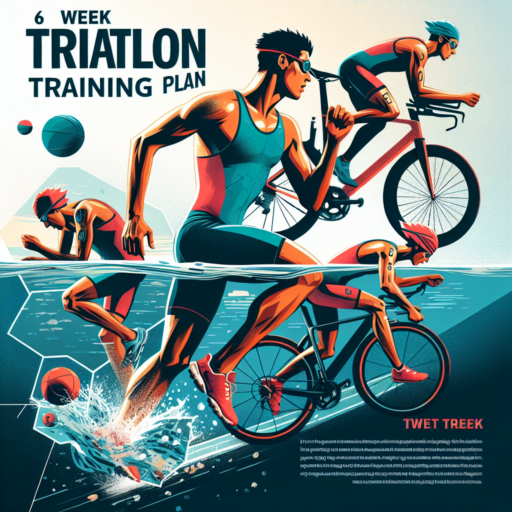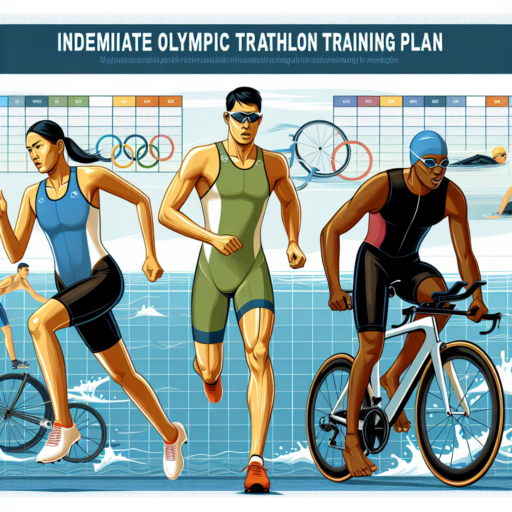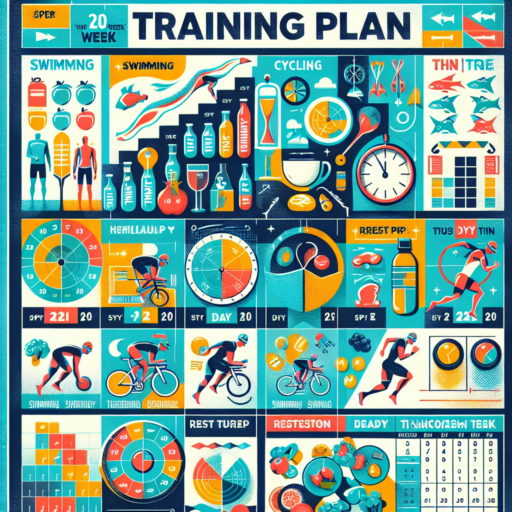Introduction to Your 6-Week Triathlon Training Plan
Welcome to your new challenge: a 6-week triathlon training plan designed to take you from enthusiastic amateur to race-ready competitor. Whether you’re aiming to complete your first sprint triathlon or looking to improve your performance, understanding the structure and commitment required over the next six weeks is crucial. This plan is crafted not only with the ambition of crossing the finish line but doing so with the confidence and skill honed through dedicated preparation.
The essence of triathlon – swimming, cycling, and running – requires a unique blend of physical endurance, mental toughness, and logistical planning. Our 6-week program is structured around gradually building your stamina in each discipline, ensuring that your body adapts to the demands of triathlon training while minimizing the risk of injury. Balance is our guiding principle; pushing your limits while allowing ample recovery time to replenish and rejuvenate. With our guidance, you’ll tackle each week with a clear focus, dedicated workouts, and actionable goals.
We believe the success of any triathlon training lies in the details. Therefore, each week of the plan includes specific sessions designed to improve your swimming technique, cycling efficiency, and running pace. Additionally, we integrate strength and conditioning exercises essential for a strong finish. Embracing this program means committing to a challenge that transforms not just how you race, but how you approach physical and mental barriers.
The Weekly Breakdown: What to Expect in Your Training
Understanding the weekly breakdown of your training program is crucial for setting the right expectations and preparing mentally and physically for the journey ahead. Whether you’re a beginner or an experienced athlete, each week brings its own set of challenges and milestones. Let’s dive into what a typical week might look like and how you can maximize your progress.
The structure of your training week is often designed to introduce variety, manage fatigue, and optimize recovery. You’ll likely encounter a mix of high-intensity sessions, moderate efforts, and rest days. Initially, the focus might be on building a base level of fitness with steady, moderate workouts. As weeks progress, the intensity and specificity of the training will increase, preparing you for the peak challenges ahead.
Key Elements of Your Weekly Training
- High-Intensity Workouts: These sessions are designed to push your limits and improve your athletic performance. Expect these workouts to be challenging but rewarding.
- Recovery and Rest Days: Equally important, these days allow your body to repair and strengthen. Embracing rest is crucial for avoiding overtraining and injuries.
- Technical Skills and Drills: Depending on your sport or activity, you might have days focused on refining technique or specific skills. These sessions are essential for overall development and efficiency.
Every week in your training journey offers the opportunity to learn and grow. By understanding the general structure and the purpose behind each workout, you can approach your training with confidence and clarity. Remember, consistency is key to seeing improvements, so embrace each week with commitment and enthusiasm.
No se han encontrado productos.
Optimizing Your Swim Technique and Endurance
Enhancing your swimming performance goes beyond just spending more hours in the pool. Optimizing your swim technique and endurance is about smarter, not harder, training. It involves a keen focus on refining your stroke efficiency and building your stamina in a way that supports sustained speed and minimizes fatigue. This strategic approach ensures that every lap you swim is a step towards a more proficient and enduring swim profile.
Key Techniques for Improved Stroke Efficiency
- Streamlining Body Position: A streamlined position in the water reduces drag and allows for smoother movement through the water. Focusing on maintaining a straight body line from the tip of your head through your toes can significantly enhance your efficiency.
- Perfecting Your Kick: The right kicking technique is crucial for driving your swim forward. Efficient kicking involves more than just your legs; it’s about engaging your core and ensuring your legs are moving from your hips, with flexible ankles.
- Mastering Breath Control: Efficient breathing techniques can greatly impact your swimming stamina and speed. Learning how to control your breath and integrating breathing with your stroke rhythm can enhance your performance and reduce fatigue.
Building Swim Endurance: Key Strategies
- Varying Training Intensity: Incorporating a mix of high-intensity interval training and longer, more moderate endurance sessions helps in building both speed and stamina. This variation encourages muscle adaptation and enhances cardiovascular health, crucial for long-distance swimming.
- Consistent Pool Time: Regular swimming is essential for endurance building. Consistency in practice not only helps in strengthening muscle memory but also in gradually increasing stamina through repetitive exposure to water resistance and swimming techniques.
< Errores Intentional
Focusing on these aspects of your swim practice can revolutionize the way you approach your time in the pool. From honing your stroke for maximum efficiency to strategically building your swimming endurance, the key to becoming a more proficient swimmer lies in attention to detail and a commitment to practice. Embrace these techniques and watch as your swimming capabilities reach new heights.
Building Speed and Stamina for the Bike Segment
When training for a triathlon or simply looking to improve your cycling performance, building speed and stamina for the bike segment is crucial. This aspect of training focuses on enhancing your physical capabilities, allowing you to maintain higher speeds over longer distances. Understanding the balance between speed work and endurance training can significantly impact your cycling proficiency.
Integrating Interval Training
Interval training is a highly effective method to boost both your speed and stamina on the bike. This type of training involves short bursts of high-intensity riding followed by periods of low-intensity cycling or rest. For example, incorporating sessions where you alternate between all-out sprints for 30 seconds and leisurely pedaling for a minute can remarkably increase your overall cycling pace. It’s not just about pushing your limits but also about recovery, which is essential for improving your biking performance.
Focusing on Consistent Long Rides
While interval training skyrockets your speed, endurance is built through consistent long rides. These sessions should be at a moderate pace, allowing your body to adapt to prolonged periods of cycling. It’s during these longer distances that you teach your muscles and cardiovascular system to sustain effort over time. Incorporating a long ride into your weekly training schedule, gradually increasing the distance, ensures a solid foundation of stamina. Remember, consistency is key; it’s better to steadily increase your distance than to push too hard too soon.
Each cyclist’s journey to improving speed and stamina on the bike is unique, influenced by individual goals, current fitness levels, and personal preferences. By balancing high-intensity intervals with enduring moderate-paced rides, cyclists can achieve a synergistic effect, enhancing both speed and stamina in harmony. Starting with these foundational principles, tailor your training to your specific goals, and you’ll see significant advancements in your cycling performance.
Increasing Running Performance for Triathletes
Certainly! Focusing on the specific H2 theme:
Triathletes face the unique challenge of excelling in three disciplines, making the optimization of running performance a critical aspect of their overall success. Improving your running efficiency can significantly impact your triathlon times, making it imperative to fine-tune this component of your training. From refining technique to incorporating strength training, the journey toward enhanced running agility demands a multi-faceted approach.
Key Strategies for Improved Run Times
Addressing the key areas crucial for boosting running performance involves a mix of training interventions and technique adjustments. Firstly, focusing on running economy can bring about considerable improvements. This involves enhancing your body’s ability to use oxygen efficiently at high speeds. Secondly, strength training specific to running not only builds muscle resilience but also significantly reduces the risk of injury, enabling more consistent training. Implementing these strategies attentively will pave the way for faster, more efficient run segments in triathlon races.
Incorporating Interval Training and Recovery
The addition of high-intensity interval training (HIIT) to a triathlete’s regimen can be a game-changer for running performance. HIIT sessions improve both speed and endurance by challenging the anaerobic system, leading to better performance over time. Equally important, however, is prioritizing recovery. Adequate rest, including active recovery and properly timed rest days, ensures that the body heals and strengthens, preventing burnout and facilitating continuous improvement.
Nutrition and Hydration Strategies for Triathlon Training
When preparing for a triathlon, understanding the nuances of nutrition and hydration can significantly affect performance. The right strategies not only power your training sessions but also enhance recovery and overall health. Balancing macronutrients, timing your meals, and staying adequately hydrated are pivotal components of a triathlete’s success.
The Importance of Macronutrients
For triathletes, a balanced intake of carbohydrates, proteins, and fats forms the cornerstone of an effective nutrition plan. Carbohydrates are the primary energy source, especially crucial during long training sessions and the race itself. Proteins are essential for the repair and growth of muscle tissue, whereas fats support sustained energy. Paying attention to the type and timing of these macronutrients can lead to improved performance and endurance.
Hydration Techniques
Hydration affects not just performance but also recovery and can significantly impact how well a triathlete trains. The goal should be to start training sessions well-hydrated and to replenish fluids regularly, especially during and after workouts. Understanding your sweat rate can help tailor your hydration strategy, ensuring you replace lost fluids effectively without overhydrating. Electrolyte balance is crucial, as these minerals support nerve function and muscle contraction, and are lost through sweat.
Adopting a strategic approach to nutrition and hydration can markedly improve a triathlete’s training and race day success. Incorporating these strategies into your regimen demands attention to detail and a commitment to tuning into your body’s signals. With practice, finding the right balance becomes an invaluable part of your training toolkit.
Recovery Techniques to Enhance Your Training Results
Improving your training results isn’t just about pushing harder in the gym or on the track. Equally important are the rest and recovery techniques you employ to allow your body to repair and strengthen. Incorporating effective recovery strategies into your routine can significantly enhance your performance and overall fitness outcomes.
One fundamental aspect of recovery is focusing on sleep quality. Adequate rest is crucial for muscle repair, hormonal balance, and overall health. Ensuring you get enough quality sleep promotes faster recovery and improves your energy levels and mood, making your training sessions more effective.
Another essential recovery technique is active recovery. This involves performing low-intensity exercise after strenuous workouts. Active recovery helps in flushing out lactic acid, reducing muscle soreness, and improving circulation. Incorporating activities such as walking, yoga, or a light bike session can make a significant difference in how quickly your muscles bounce back.
Essential Gear and Equipment for Your Triathlon Training
Embarking on a triathlon journey requires not just grit and discipline but also the right gear and equipment to ensure safety, comfort, and performance optimization. From the swim to the bike to the run, each segment demands specific items that can significantly impact your training and competition outcomes. Understanding the essential gear and equipment for your triathlon training is crucial for beginners and seasoned athletes alike.
Swim Essentials
In the aquatic segment of the triathlon, the focus is on maximizing speed while ensuring safety. A high-quality, triathlon-specific wetsuit is indispensable for providing buoyancy, reducing drag, and offering thermal protection in open water. Goggles with clear visibility and anti-fog properties are crucial for navigation, while a snug-fitting swim cap can reduce resistance and protect your hair from chlorine or saltwater. Don’t overlook the importance of lubricants to prevent chafing from your wetsuit around the neck and arms.
Bike Equipment
Transitioning to the bike segment, selecting the right bicycle that fits your body and suits the race’s requirements is paramount. A road bike or a triathlon-specific time trial bike, equipped with aero bars for better aerodynamics, can make a significant difference in your performance. Investing in a quality helmet that provides optimal airflow and safety is non-negotiable. Additionally, cycling shoes that clip into your pedals can enhance power transfer and efficiency, making every pedal stroke count.
Run Gear
For the final leg of the triathlon, comfortable and breathable running shoes are essential to prevent injuries and improve speed. A quick-drying, technical fabric running outfit can help manage sweat and reduce chafing, ensuring focus and comfort until the finish line. Don’t underestimate the importance of race belts and number tattoos for ease of identification and compliance with race regulations. Selecting gear with built-in storage for nutrition and hydration is also critical for maintaining energy levels throughout the race.
Tips to Stay Motivated Throughout Your 6-Week Plan
Staying motivated throughout a 6-week plan can pose a challenge, especially when the initial excitement wanes. However, adopting specific strategies can make the journey not only bearable but also enjoyable and successful. Here we delve into practical tips aimed at keeping your motivation levels high.
Set Clear and Attainable Goals
One of the most effective ways to maintain motivation is by setting clear, achievable goals. Break down your 6-week plan into smaller, manageable objectives. Celebrate each milestone, no matter how small, to keep the sense of achievement alive. This tactic helps to create a positive feedback loop that boosts your motivation throughout the plan.
Find Your Support System
Another crucial element in staying motivated is having a robust support system. Whether it’s friends, family, or an online community, surround yourself with people who understand your goals and encourage you to keep going. Sharing your progress and challenges can provide you with new perspectives and much-needed moral support.
Mix It Up
Last but not least, remember the importance of variety. A repetitive routine can lead to boredom, which is a major motivation killer. Keep your plan exciting by mixing up activities, trying new methods, or incorporating fun elements into your routine. This will not only sustain your interest but also challenge different aspects of your abilities, contributing to overall growth.
Preparing for Race Day: The Final Week Checklist
As race day approaches, the final week is crucial for ensuring you are as prepared as possible, both physically and mentally. This period is about fine-tuning your training, nutrition, and rest to optimize your performance. It’s not just about the months of training leading up to the event but also making sure your last week’s preparations are meticulously planned and executed. Below, we’ll dive into some key aspects to focus on during the final countdown to your race.
1. Taper Your Training
One of the most critical strategies in the final week is to taper your training. This means gradually reducing the volume and intensity of your workouts to allow your body to rest and recover. It might seem counterintuitive to decrease training when the race is so close, but tapering helps to ensure that your muscles are well-rested and primed for optimal performance on race day. Focus on maintaining your fitness level without overexerting yourself, incorporating light jogs, short sprints, or gentle swims into your routine, depending on the race you’re preparing for.
2. Optimize Nutrition and Hydration
Nutrition and hydration play a pivotal role in your final week preparations. It’s time to focus on carb-loading to ensure your energy stores are fully stocked. However, it’s essential to start this process slowly, increasing your carbohydrate intake in the last three days before the race, to avoid feeling sluggish or bloated. Likewise, staying hydrated is key, but remember to increase your water intake gradually and avoid overhydrating. Consider adding electrolyte-rich drinks to maintain a balance of minerals in your body, which can be crucial for preventing cramps and fatigue during the race.
Ultimately, the final week before your race is about setting the stage for a successful and enjoyable race day. By taper swearing off, focusing on balanced nutrition, and ensuring you’re getting plenty of rest, you’ll position yourself for the best possible outcome. Remember, all the hard work has been done; now it’s time to trust in your training, listen to your body, and look forward to crossing that finish line.




